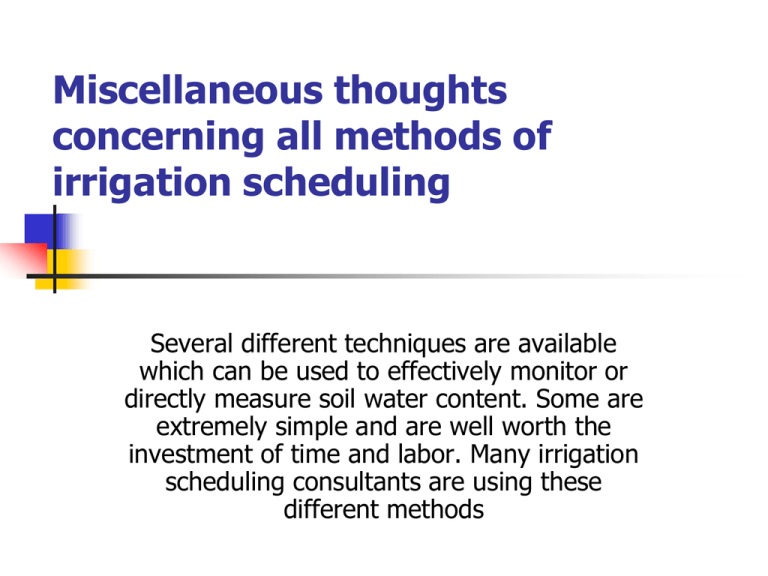Miscellaneous thoughts concerning all methods of irrigation scheduling
advertisement

Miscellaneous thoughts concerning all methods of irrigation scheduling Several different techniques are available which can be used to effectively monitor or directly measure soil water content. Some are extremely simple and are well worth the investment of time and labor. Many irrigation scheduling consultants are using these different methods Table 5. (Thomas W. Ley, Robert G. Stevens, Richard R. Topielec and W. Howard Neibling) Qualitative evaluation of soil water monitoring devices. 1 is Least favorable while a score of 10 is most favorable. NP Neutron Probe; TDR Time Domain Reflectometry; GS Gravimetric Sampling; AP Troxler Sentry 200-AP; AQ Aquaterr Probe; TM Tensiometer; GB Gypsum Block; WB Watermark Block; Disadvantages of Fixed Point Soil Moisture Monitoring: Several locations and depths must be monitored to make sure your measurements are representative of the entire field. Irrigation systems often are extremely variable Movement of water on the surface of the soil leaves wet and dry spots, often within a few feet of each other. Moving a water mark sensor or tensiometers a few meters away might give very different readings. Moving to a different location in the field will likely encounter a completely different soil. Limitations of Hand Augering Using a hand auger or tile spade can be much more representative of the field as a whole; The actual estimate of percent soil moisture is less accurate. Hand augers are not as convenient to quickly measuring soil moisture in deeper depths. Tile spades are limited to 24 inches or so; augers are limited by gravel or small rocks in the soil Using the Checkbook Method of irrigation scheduling, ”When should you begin the next irrigation following an extended rainy spell when the soil profile is completely full across the entire field.??” Be careful! This is often the time a farmer will get into trouble and “burn up” a crop. Here’s how I suggest proceeding: 1. Wait one day on sandier soils, two days on heavier soils to allow the excess soil moisture to drain from the soil. Do not consider ET during those days. 2. Begin the next irrigation when the accumulated ET has reached around one half of the planned irrigation amount. Actually you would begin irrigating when depletion is only 25% of the Available Water in the root zone Slow the pivot down to additionally apply the each successive day’s ET. Continue to slow down only until you reach your Planned Application Amount Irrigation Scheduling Falls into Three Categories for Center Pivots that have adequate water available on demand 1. Time Based: eg. Irrigate every 3 days applying ET for those days. 2, Amount Based: eg Irrigate when accumulated ET equals a pre planned amount. 3. Fixed Time – Fixed Amount : Irrigate every two days with 0.5 inches. Actually this is NOT IRR SCHEDULING Time Based Irrigation Schedule 1. When water supply is adequate, this almost always results in too much water applied. Lack of soil oxygen often results in poor root growth, soil pathogen problems, etc. Amount Based Irrigation Schedule If water supply is overestimated, the system fails unless: 1. % Timer Charts are updated as needed And Soil moisture is regularly checked before and after irrigations.


